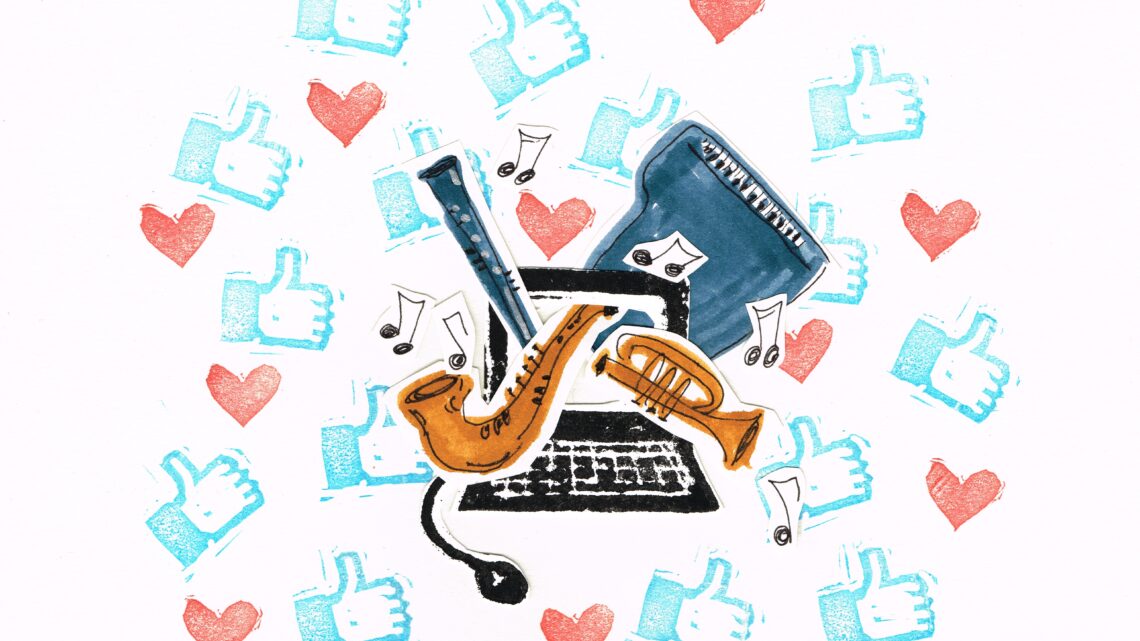The Digital Age of Music and all that Jazz
In the modern day, the art of music is as broad as ever. There are no constraints as to what artists can create, arguably with the only limits being their own imagination and technical proficiency. Nowadays, however, it is easier than ever before to reach out and find someone suitable to help the idea come to life, be it a more skilled instrumentalist, a vocalist just right for the part, a composer or a producer who can bring more colour to the soundscape, or a mixing engineer who puts the finishing touches on the final piece and makes sure the sound quality does it the justice it deserves. And a lot of this musical networking is, like many other things nowadays, done through and influenced by social media.
In the jazz scene circles, which are relatively small on a global scale, creating a community through live shows is just as vital as maintaining a digital image. Social media allows for a virtually unlimited outreach of the content that the artists may choose to post on the platforms, as well as seamless and effortless communication with the fans. Creating lasting connections and a dedicated fanbase has always been a demanding process, but nowadays it is not quite what it used to be.
Artists’ promotion on the internet has been evolving as fast as the medium itself and has become a vital part of their marketing strategy. In recent years, however, the change was especially drastic with the sudden rise in popularity of short-form video content initially offered by TikTok and then implemented on Instagram as Reels and on YouTube as Shorts. With that came the change in the social media’s algorithms that shifted the emphasis from social graphs to interest graphs (Wei, 2020), which in turn shifted artists’ focus on audiences instead of communities (Conte, 2023). Creators were essentially forced to make content based on tackling certain points of interest in order for their work to get promoted, which does not necessarily align with earlier established methods for building long-lasting communities of followers. However, on the other side, there are artists who managed to use the algorithms to their advantage.
The most notable phenomenon of such characteristics related to the jazz scene is that of Laufey – Grammy-winning Icelandic-Chinese multi-instrumentalist and songwriter out of Berklee College of Music. Being able to not only blend her jazz influences with popular music formulas and resonate with audiences through her lyrics, but to also use social media to her advantage, she has experienced an enormous success in her career, while broadening many, often young, people’s musical horizons. Though Laufey does not fall strictly into the brackets of either jazz or pop, her references to classic artists, such as Chet Baker and Ella Fitzgerald, allow some her fans to be exposed to great music of decades past. The difference in this case is the mainstream fashion in which that occurs, and the sheer power of numbers behind it.
According to data from Songstats, Laufey has seen an exponential increase in TikTok and Instagram likes and views of videos featuring her music since the release of the first of the album’s singles, “From The Start”, in early May 2023. Since then, the artist has peaked at over 1.32 billion TikTok views with over 944% increase and over 48 million on Instagram with over 810% increase over the course of less than six months, on top of approximately 21,838% and 9,195% respective increases since the release of the first single from her previous, debut album in February 2022. The social media growth can be clearly seen to have also reflected itself in Laufey’s Spotify monthly listeners, peaking at almost 27 million with an almost 800% increase since May 2023 alone and 3,259% since February 2022. Given how incredibly effective social media are in promotion of artists’ music nowadays, it is no surprise that they also affect their incomes in an unsubtle manner.
Watson, A., Watson, J. B., & Tompkins, L. (2022) found a positive co-evolution between artists’ social media following and music streams on online streaming platforms with “potentially significant increases in artist royalty incomes resulting from increases in followers”, as well as a strong correlation between their following on said streaming platforms and the total revenue from live performances. Within the music industry, streaming makes up 84% of all revenue, a 10.3% increase from the previous year, according to the RIAA mid-year 2023 revenue report. At the same time, artists can expect a gross payout of anywhere between $1.10 and $12.84 per 1,000 streams, varying with different streaming platforms (Virpp, 2023), and when combined with the ease and accessibility of releasing music online (DistroKid, one of the more popular digital distribution services, offers plans starting at €20.99 per year while letting artists keep 100% of the revenue and ownership), it becomes an invaluable source of income for all artists, especially those working independently. It is not, however, a sustainable one on its own.
According to a study by Future of Music Coalition from 2012, surveying almost 4,500 artists working mainly in jazz, rock, and country scenes, the main sources of musicians’ income include live performance, at 27% income share, teaching, at 22%, salaried playing, at 20%, session work, at 11%, composition, at 6.3%, sound recordings, at 5.6%, merchandise sales, at 1.6%, and other sources at 6.4% (Output, 2021). Even though the data collected is from before the “era” of online streaming, it is clearly visible that artists have always had a diversified income. Within the jazz scene, the focus, possibly far greater than in other scenes due to the inherent improvisational nature of the art, is still on live performances, be it local shows or nation- and world-wide tours. Social media help artists reach out to audiences nearby or far away and make collaborations and brand partnerships possible in an effortless manner compared to their predecessors’ potential in the past decades. Internet shops allow for online merchandise sales often only limited by the artists’ supply, but it is still a common practice for merchandise to be sold in venues where the live shows take place. Moreover, the overall technological development makes teaching more accessible than ever, with musicians often giving lessons through online video communicators, resulting in a global range, but also allows artists to work together without the constrains of a physical space. This kind of flexibility in the environment has led to great many collaborations taking place that otherwise could not have been feasible, rendering the music world open to endless possibilities.
Though, as with any kind of progress, some artists need to adjust in order to be able to fully take advantage of the current state of affairs when it comes to social media promotion, many approaches are becoming normalised, especially with younger generations becoming an increasingly significant fraction of the music industry. There is a very slim chance that anything will stay the same about the way musicians can use the internet outlets to grow their fanbase, quite possibly they may have a hard time catching up with the changes that may occur in the years to come. There will, nonetheless, be a number of hiccups that artists might encounter, such as the latest controversial situation with Universal Music Group, who has accused TikTok of insufficient royalty payments for their artists music (Sisario, 2024). In turn, the recording label’s artists’ music has been removed from the platform, both from already existing videos, as well as from the library of tracks available for creation of new ones. This shows that universal, successful methods of navigating the promotion on social media are still just out of reach, and a lot of work must be done on both the artists’ (and their labels’) and the platforms’ ends. Nonetheless, even with the current system, there is an undeniable and extraordinary potential in the extent to which musicians can use social media to broaden their outreach, and with a healthy amount of wishful thinking, it is only going to improve in the foreseeable future.
Reference list:
Wei, E. (2020, August 4). TikTok and the Sorting Hat. eugenewei.com. Accessed February 7th, 2024, https://www.eugenewei.com/blog/2020/8/3/tiktok-and-the-sorting-hat
Conte, J. (2023). Audience and community are different things. Instagram. Accessed February 7th, 2024, from https://www.instagram.com/reel/Cqa0DYXIgww/.
Songstats. (n.d.). Music Data Analytics for artists & labels! https://songstats.com/
Watson, A., Watson, J. B., & Tompkins, L. (2022). Does social media pay for music artists? quantitative evidence on the co-evolution of social media, streaming and live music. Journal of Cultural Economy, 16(1), 32–46. https://doi.org/10.1080/17530350.2022.2087720
Music streaming payouts comparison: A guide for musicians. VIRPP. (2023, July 17). Accessed February 7th, 2024. https://virpp.com/hello/music-streaming-payouts-comparison-a-guide-for-musicians/
Output. (2021). How Much Do Musicians Actually Earn? Output. Accessed February 7th, 2024. https://output.com/blog/how-much-musicians-actually-earn
Sisario, B. (2024, February 1). Universal Music Group Pulls Songs From TikTok`. The New York Times. Accessed February 7th, 2024.

Bartosz Skitał is an Economics student at UvA with growing interest in researching human behaviour in economic context. He is also very passionate about music and often spends his free time exploring the art and its culture, as well as improving his guitar playing and overall composition and production skills. For Inter, Bartosz is a quality controller as well as a writing editor.

